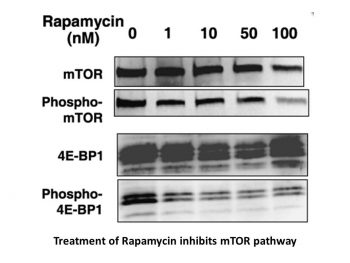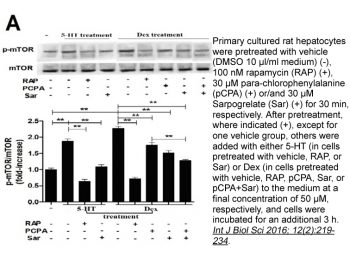
| Size | Price | Stock | Qty |
|---|---|---|---|
| 5mg |
|
||
| 10mg |
|
||
| 25mg |
|
||
| 50mg |
|
||
| 100mg |
|
||
| 250mg |
|
||
| Other Sizes |
|
Purity: ≥98%
SF1670 is a highly potent and specific PTEN inhibitor with IC50 of 2 μM. SF1670 increased PtdIns(3,4,5)P3 signaling in neutrophils by interacting with the active site of PTEN. In particular, SF1670 increased PtdIns(3,4,5)P3 signaling and significantly increased Akt phosphorylation stimulated by chemoattractant in human neutrophils. At a 250nM concentration, SF1670 effectively increased Akt phosphorylation. Additionally, SF1670 increased PtdIns(3,4,5)P3 signaling and Akt phosphorylation in mouse neutrophils, which were both mediated by the inhibition of PTEN activity.
| Targets |
PTEN (IC50 = 2 μM)
|
|---|---|
| ln Vitro |
SF1670 shows potent cytotoxicity in HBEC, PC-3, H1299 cells with IC50 of 5 μM, 10 μM, 44 μM, respectively. The angiogenic processes are stimulated by SF1670 in a mouse aortic ring matrigel angiogenesis model. Chemoattractant-induced PtdIns(3,4,5)P3 signaling is enhanced and neutrophil functions are improved by SF1670. [1]
|
| ln Vivo |
Pretreatment with SF1670 (500 nM i.v.) improves neutropenic mice's ability to kill bacteria in both peritonitis and bacterial pneumonia and lowers pneumonia-related mortality. [1]
|
| Enzyme Assay |
The general PTEN inhibition assay evaluates doses of test compounds ranging from 1 nM to 250 uM (final reaction mix concentrations) in order to determine the dose response of potential PTEN inhibitors. Two distinct rounds of the dose response assay are carried out to obtain the performed IC50 data. PTEN activity is initially tested with inhibitor present at 10-fold serial dilutions ranging from 1 nM to 250 uM. The PTEN inhibition assay is then repeated after identifying the concentration range at which PTEN activity changes significantly. Two additional concentration data points within this range are then added. The inhibitor concentration at which 50% of PTEN activity occurs is known as the PTEN inhibition IC50. When the assay was run on multiple occasions and gave slightly different IC50 then those are reported as a range of IC50 found.
|
| Cell Assay |
In RPMI 1640 medium supplemented with 10% FBS, cells are plated into 96-well plates and incubated overnight at 37°C in an incubator with an atmosphere of 5% CO2. The medium is changed the next day, and cells are starved by putting them in 100 uL of serum-free medium for three hours. The wells are filled with serially diluted test compounds, and the cells are then incubated with them for two hours at 37°C. Depending on their solubility, compounds are tested in a range from 1 mM to 0.1 nM. At a final concentration of 5 g/ml, MTT is added to the wells and incubated with the cells for three more hours. After the incubation is complete, the medium is aspirated, and 100 μL DMSO is added to dissolve the MTT stain in the cells. The optical density of each well is then determined at 570 nm using a SpectroMax Plus spectrophotometric plate reader. Prism software was used to determine the IC50 based on the data.
|
| Animal Protocol |
Neutropenic mice
500 nM Tail-vein injection |
| References |
|
| Molecular Formula |
C19H17NO3
|
|
|---|---|---|
| Molecular Weight |
307.34
|
|
| Exact Mass |
307.12
|
|
| Elemental Analysis |
C, 74.25; H, 5.58; N, 4.56; O, 15.62
|
|
| CAS # |
345630-40-2
|
|
| Related CAS # |
|
|
| PubChem CID |
9926586
|
|
| Appearance |
Pink to red solid powder
|
|
| Density |
1.3±0.1 g/cm3
|
|
| Boiling Point |
554.1±29.0 °C at 760 mmHg
|
|
| Flash Point |
208.0±24.4 °C
|
|
| Vapour Pressure |
0.0±1.5 mmHg at 25°C
|
|
| Index of Refraction |
1.637
|
|
| LogP |
3.22
|
|
| Hydrogen Bond Donor Count |
1
|
|
| Hydrogen Bond Acceptor Count |
3
|
|
| Rotatable Bond Count |
2
|
|
| Heavy Atom Count |
23
|
|
| Complexity |
519
|
|
| Defined Atom Stereocenter Count |
0
|
|
| SMILES |
O=C(C(C([H])([H])[H])(C([H])([H])[H])C([H])([H])[H])N([H])C1C([H])=C([H])C2C3=C([H])C([H])=C([H])C([H])=C3C(C(C=2C=1[H])=O)=O
|
|
| InChi Key |
VZQDDSYKVYARDW-UHFFFAOYSA-N
|
|
| InChi Code |
InChI=1S/C19H17NO3/c1-19(2,3)18(23)20-11-8-9-13-12-6-4-5-7-14(12)16(21)17(22)15(13)10-11/h4-10H,1-3H3,(H,20,23)
|
|
| Chemical Name |
N-(9,10-dioxophenanthren-2-yl)-2,2-dimethylpropanamide
|
|
| Synonyms |
SF1670; SF-1670; SF 1670
|
|
| HS Tariff Code |
2934.99.9001
|
|
| Storage |
Powder -20°C 3 years 4°C 2 years In solvent -80°C 6 months -20°C 1 month |
|
| Shipping Condition |
Room temperature (This product is stable at ambient temperature for a few days during ordinary shipping and time spent in Customs)
|
| Solubility (In Vitro) |
|
|||
|---|---|---|---|---|
| Solubility (In Vivo) |
Solubility in Formulation 1: ≥ 2.5 mg/mL (8.13 mM) (saturation unknown) in 10% DMSO + 90% Corn Oil (add these co-solvents sequentially from left to right, and one by one), clear solution.
For example, if 1 mL of working solution is to be prepared, you can add 100 μL of 25.0 mg/mL clear DMSO stock solution to 900 μL of corn oil and mix evenly. (Please use freshly prepared in vivo formulations for optimal results.) |
| Preparing Stock Solutions | 1 mg | 5 mg | 10 mg | |
| 1 mM | 3.2537 mL | 16.2686 mL | 32.5373 mL | |
| 5 mM | 0.6507 mL | 3.2537 mL | 6.5075 mL | |
| 10 mM | 0.3254 mL | 1.6269 mL | 3.2537 mL |
*Note: Please select an appropriate solvent for the preparation of stock solution based on your experiment needs. For most products, DMSO can be used for preparing stock solutions (e.g. 5 mM, 10 mM, or 20 mM concentration); some products with high aqueous solubility may be dissolved in water directly. Solubility information is available at the above Solubility Data section. Once the stock solution is prepared, aliquot it to routine usage volumes and store at -20°C or -80°C. Avoid repeated freeze and thaw cycles.
Calculation results
Working concentration: mg/mL;
Method for preparing DMSO stock solution: mg drug pre-dissolved in μL DMSO (stock solution concentration mg/mL). Please contact us first if the concentration exceeds the DMSO solubility of the batch of drug.
Method for preparing in vivo formulation::Take μL DMSO stock solution, next add μL PEG300, mix and clarify, next addμL Tween 80, mix and clarify, next add μL ddH2O,mix and clarify.
(1) Please be sure that the solution is clear before the addition of next solvent. Dissolution methods like vortex, ultrasound or warming and heat may be used to aid dissolving.
(2) Be sure to add the solvent(s) in order.
|
 |
 |